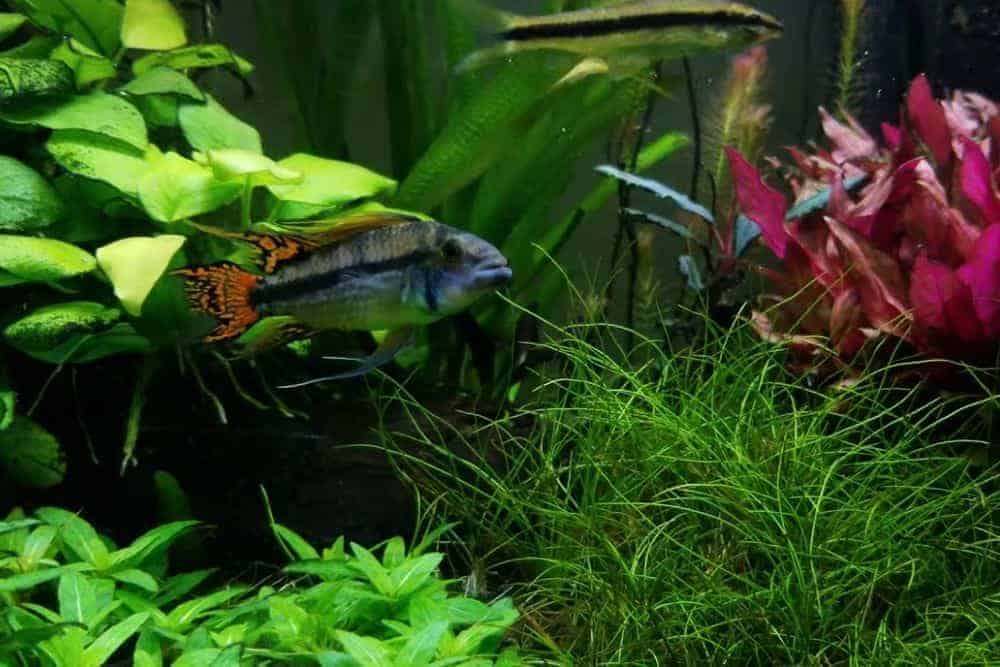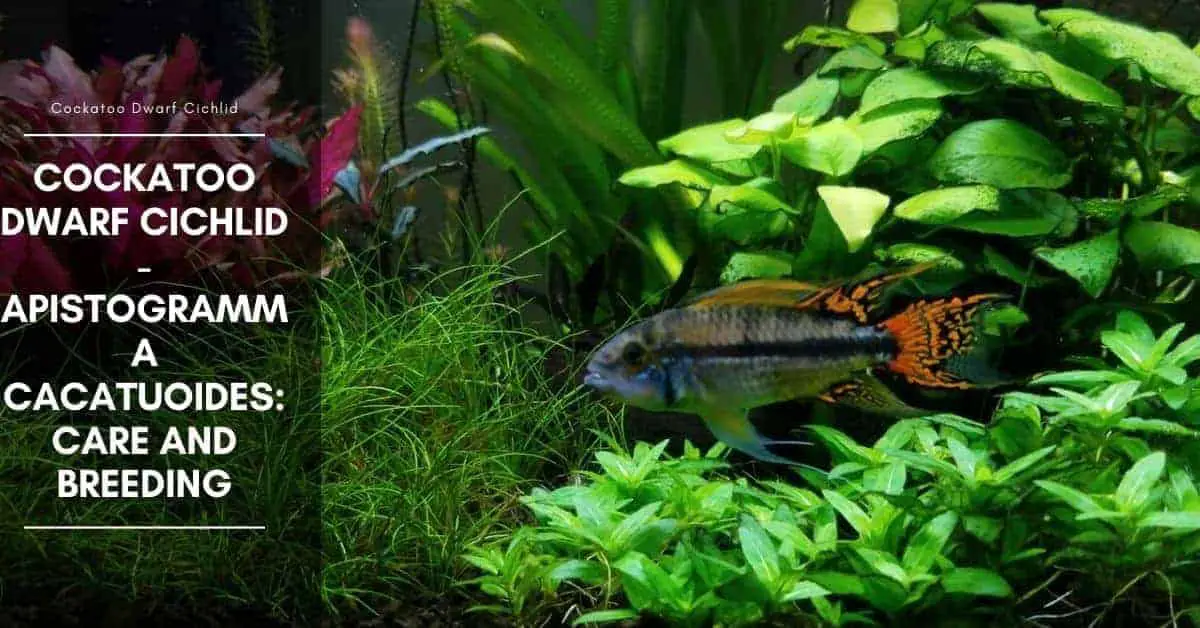This article is about raising and fertilizing one of the most popular dwarf cichlids. That is Cockatoo dwarf cichlid. This article is appropriate for the amateur and anyone who wants to learn about this fish before getting starting. How we raise them until they will have the next generation.
Recommended Tank Parameters For Cockatoo Dwarf Cichlid
- Temperature: 70° – 83°F (21° – 28°C)
- pH: 6.0 – 7.2: If these cichlids are tank-raised species they are more flexible with the pH level.
- KH: 2 – 14 KH
- Minimum tank size: 25 gallons for a pair of Cockatoo Dwarf Cichlid, but a larger tank is required for a group.
In the group of colorful dwarf cichlid, which are interested in many people, with their small colorful, their fins which can reinforce the high jump will attract many people. Moreover, some people know the Cockatoo cichlid as “recommended dwarf cichlid” for the beginners. Do you know that the Cockatoo is recommended for the beginners? Are there any differences from other dwarf cichlids?
The scientific name of the Cockatoo dwarf cichlid is Apistogramma cacatuoides, one of the members of the famous Apistogramma from South America as well as “Borel” (Apistogramma borellii) and “Agassiz” (Apistogramma agassizii) which are famous for the beginners. If we look roughly, Cacatuoi is alike two of the Apistogramma. One of the dominant points of Cacatuoi is the female back mast along the back, which is as high as cockatoos’ crest. That is the source of the Spanish name “Cactuoides” which means “alike cockatoo”, which is appropriate for it.
Because of the attractive shape, Cacatoui is popular around the world and the colors are various and the species are different, along with affordable prices and easy to buy, as well as flexible with different water conditions. Although it is weaker than the bigger climbing perches, it’s not sensitive to a different condition. Some kinds of climbing perches can die is the water condition is not well-prepared, and the feeder will be sad and lost their money (very important). That allows Cacatoui is very popular in the top list.
This cichlid can live in many different aquariums such as a planted tank or specific aquarium for them. The aquarium preparation is not different from other Apistogramma. But water condition is not needed to adjust the pH value by using specific soil or Indian Almond’s leaves because Cacatiou can live in the general water better than others.
API STRESS ZYME Freshwater and Saltwater Aquarium Cleaning Solution 16-Ounce Bottle
API ACCU-CLEAR Freshwater Aquarium Water Clarifier 4-Ounce Bottle
12% OffAPI GENERAL CURE Freshwater and Saltwater Fish Powder Medication 10-Count Box
15% OffEven the most forest Cacatiou is not from “Black Water” like other dwarf cichlids. Feeders don’t need to adjust the water condition to be Black water, but, the water condition needs to always be stable. The log and water tree should be added to the aquarium to comfort the fish’s feelings and show their colors. Moreover, the messy aquarium will decrease the risk of biting. (But the feeders may not see the fish clearly. We need to understand their nature. One thing we can do is “Sneaking”.

Cockatoo Dwarf Cichlid Tank Mates
Cockatoo is not interested in the other fish which have different behavior. So, they can be raised with various small fish. On the other hand, the small-size fish can be eaten by cacatiou.
From my experience, Cacatiou is not fierce comparing with other kinds. But, they may be aggressive especially with the same cockatoo cichlid. The 16-inch or 24-inch width of the aquarium is appropriate for 1 male and 1-2 female. Feeders must be careful if there are more cockatoo cichlids in the aquarium and feeder should prepare the reserve box for them. Another technique is the fish will decrease the aggressiveness when their sex is the same. But, their color will be not bright and the court between males and females along to the family activities are not existed, which are the charming of them.
What do Cockatoo Dwarf Cichlids Eat?
We need to feed the cockatoo with sufficient cichlids food because many kinds of fish especially the flock of the high speed can eat the food faster. And goatfish will eat the eggs and the baby fish in the nighttime.
Cockatoo likes to at fresh food, but feeders should avoid frozen and alive red worms and water worms because these can be the carrier of parasites disease. If the cockatoo cichlid sick, it’s hard to cure because it’s not getting along well with chemical matters and can die easily rather than survive. For the Cacatiou, it’s not a problem because the fish in the market are fed fish, not come from the forest. So, they can accept instant food easily. However, high-protein food should be considered first.
Breeding Apistogramma Cacatoides and Laying Eggs
Cockatoo Dwarf cichlids begin to fertilize when their bodies are around 1 inch long. Their age is around 4 months. Female cockatoo will be ready before males. Their bodies will be bright yellow and start to court the male. They always choose the biggest and most perfect male cockatoo. Whether the species is different, they will use a hole or small cave to lay their eggs. They will lay their eggs at the ceiling wall. Feeders can put the small pot, which can remove it for hatching in other objects by flowing the water passing through the eggs to imitate the female cacatiou’s behavior.
Baby Cockatoo Cichlids
The color of Cacatiou’s eggs is yellow-orange. The waste eggs are pale white. The eggs will be hatched within 3 days. Baby cockatoo cichlid has a red sack and lies at the floor around 5 days. We should feed the food to the baby cacatiou when they started swimming. The food may be small worms and artemia in the little dose, but more often. When baby cockatoo can eat artemia very well, feed them with artemia because the baby cacatiou will grow faster.
Mother cacatiou is better at baby caretaker better than others. Father cacatiou don’t harm the baby but don’t do anything. The problem is mother cockatoo would lay her new lot of eggs even the baby cockatoo is so small. In this case, mother cacatiou would not protect the baby cockatoo and harm or eat the baby cacatiou instead.
We can prevent this by separating the new eggs and hatch by ourselves, or separate the father cockatoo to stop laying eggs. The feeder should plan from choosing the fish. Avoid matching the fish from the same source because the baby cockatoo can be weak or disabled. The most problems of cockatoo are inbreeding and the next generation will be down quality.

Hi, my name is Sean, and I’m the primary writer on the site. I’m blogging mostly about freshwater and saltwater aquariums, fish, invertebrates, and plants. I’m experienced in the fishkeeping hobby for many years. Over the years I have kept many tanks, and have recently begun getting more serious in wanting to become a professional aquarist. All my knowledge comes from experience and reading forums and a lot of informative sites. In pursuit of becoming a professional, I also want to inspire as many people as I can to pick up this hobby and keep the public interest growing.
Read more about Sean.
Please join also my Facebook group.















